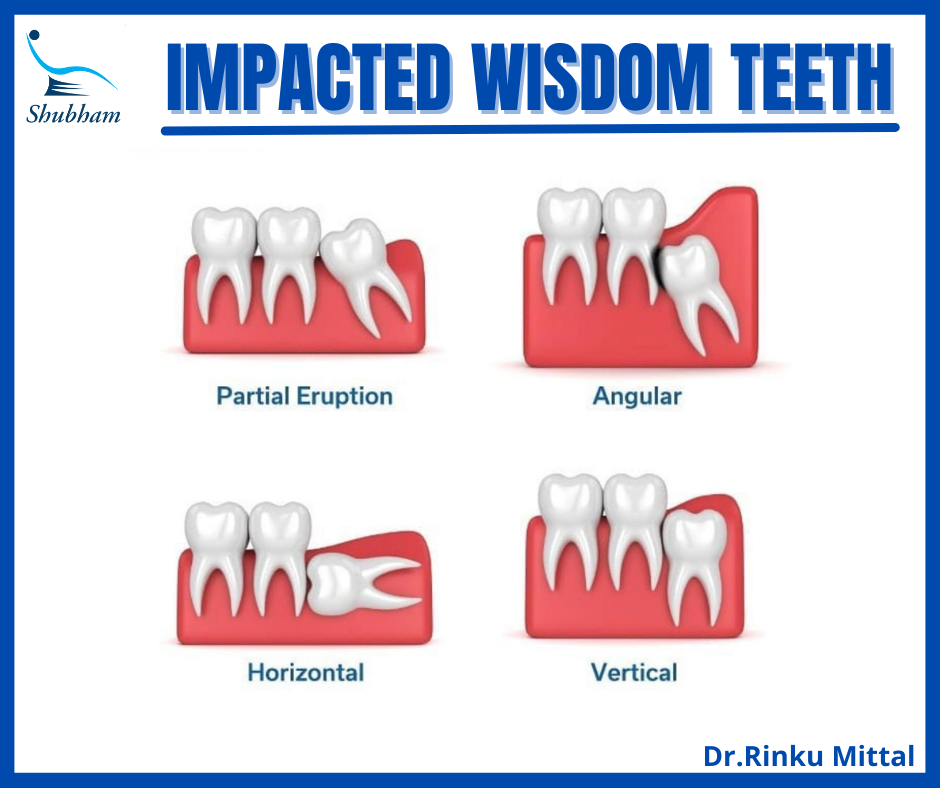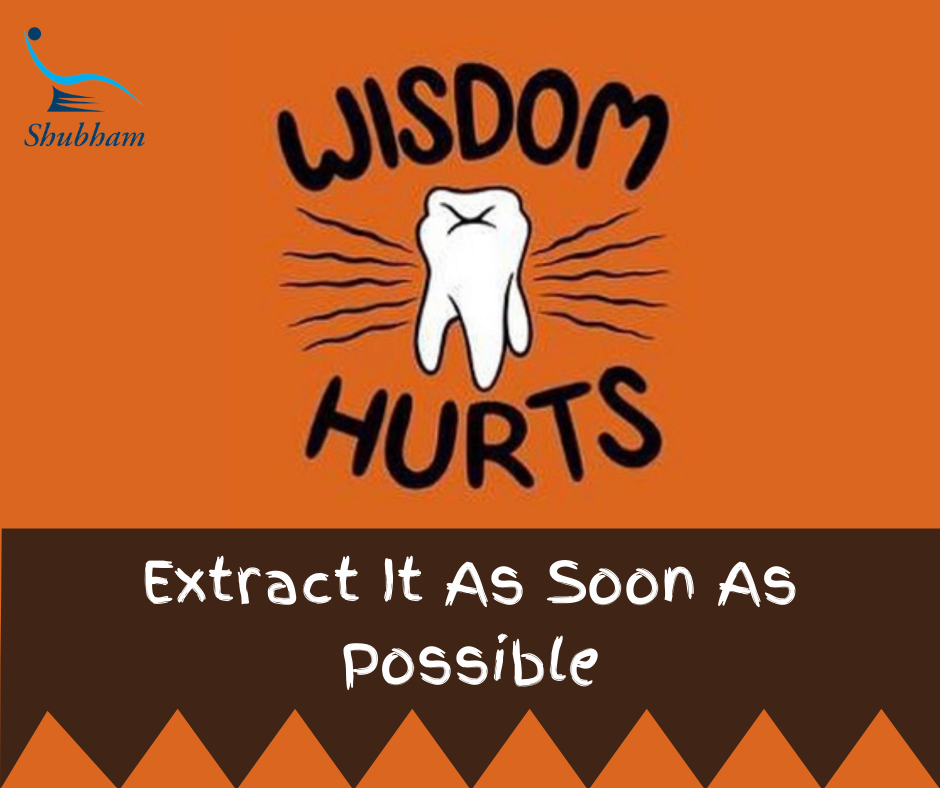WHAT IS A WISDOM TOOTH?
Do you have any idea why they are called wisdom teeth??
It’s because they erupt at a time when you are supposed to gain prudence or wisdom as it is called.
A wisdom tooth is another name of the third molar present in the mouth in all four quadrants in adults. Wisdom teeth are the last of your teeth to appear in the oral cavity. Most people have four wisdom teeth at the back of the mouth-two in the bottom and two in the top. They usually erupt in the mouth between the late teens and early twenties when many people are in college or starting new jobs, hopefully learning and gaining wisdom.
Most problems with wisdom teeth happen around the age of 15 to 20 years. Few people more than 30 years of age have problems with their wisdom teeth that need removal. Some people never develop wisdom teeth. For others, wisdom teeth erupt normally, just as their other molars did, and cause no problems.
IMPACTED WISDOM TEETH
Wisdom teeth that do not have enough room in the mouth to fully erupt because of blockage from other teeth and not being able to break through your gums are known as IMPACTED WISDOM TEETH. It results in painful, swollen, and infected flaps in your gums. Impacted wisdom teeth are more prone to disease, dental caries, and other dental issues.
An impacted wisdom tooth may:
- Be tilted towards the second molar (Mesio-angular Impaction)
- Be tilted towards the back of the mouth (Disto-angular Impaction)
- Grow at a right angle to the other teeth, as if the wisdom tooth is lying down within the jaw bone(Horizontal Impaction)
- Third molar is parallel to second molar but stay trapped within the jawbone (Vertical Impaction)

SIGNS AND SYMPTOMS OF AN INFECTED WISDOM TOOTH
Various signs and symptoms of infected wisdom teeth are:
- Pericoronitis– An impacted wisdom tooth will start to push through the gum and an infection can start around the tooth. When the wisdom tooth is not able to fully come out of the mouth, it is called a partially erupted wisdom tooth. The soft tissue flap over this partially erupted wisdom tooth is called an operculum. If bacteria gets entrapped under the operculum, then an infection can occur which is called pericoronitis. This inflammation and infection around the tooth can cause headache, swelling, tooth pain, and stiffness of the jaw.
The symptoms of infection are red, swollen gums, bad smell, pain while biting, and sometimes even pus is oozing out from the gums. It may cause even swelling in cheeks, gums, or the affected side of jaws. The pain may radiate to the head and ear.
2. Dental cyst– The dental sac within the gum line which houses the wisdom tooth can become fluid-filled during impaction of the third molar and form a cyst. This cyst can damage the bone or roots of the teeth.
3. Erosion cavity (resorption) – An impacted wisdom tooth may keep pushing the molar next to it. This can cause an erosion cavity where the third molar strikes the adjacent tooth. This often leads to serious damage to both the molars. It may cause pulp exposure in the adjacent second molar. Food debris may get trapped between the teeth or under the gum flap leading to infection or gum disease.
4. Dental crowding –A wisdom tooth may push nearby teeth out of their correct position and may cause malocclusion or crowding of front teeth.
RIGHT TIME TO GET THE IMPACTED WISDOM TEETH REMOVED

Wisdom teeth may need to be removed if there are the following signs:
Pain and swelling
Usually, many impacted teeth remain in your mouth for years together without causing any discomfort. But if you are experiencing pain, swelling, pressure, and discomfort in the backside of your lower jaw, then it’s time to get your wisdom tooth removed. Pericoronitis is one of the most common indications of an emergency extraction of a wisdom tooth.
Dental cavity
Sometimes wisdom teeth are so posteriorly placed that it’s impossible to clean them. That leads to deep cavities and pain. It’s always best to get such partially erupted and decayed teeth extracted if they are not upright.
Damage to the neighboring tooth
Horizontally placed wisdom teeth impinge the nearby molars and make them more susceptible to tooth decay. If it is clear that the tooth will not have room to grow, then such wisdom teeth should be extracted before they cause any damage to the nearby tooth.
EASY WAYS TO RELIEVE WISDOM TOOTH PAIN/ HOME REMEDIES TO RELIEVE PAIN
If you are feeling some pain and pressure at the back of your mouth and you think it might be due to either an erupting wisdom tooth or a potential infection, you can try these methods to decrease the pain.
- Salt water– Dissolve a pinch of salt in a glass of warm water and swish it in the mouth for 30 seconds. Do these warm saline mouth rinses, several times a day. This helps to draw out bacteria and initial infection. Keep the area around the third molar clean. Salt water won’t permanently cure but it will give temporary relief.
- Cloves– Place one or two cloves on the site of the pain to get temporary relief. If it is used for long, it can cause burns or irritation.
- Garlic– Make a paste with minced garlic and salt and place it in the area of concern. It will give temporary relief, but it is difficult to handle the strong odor of garlic.
- Teabags– Peppermint tea has numbing properties, so it can also be used.
- Pain killers-If you have a mild, dull ache that is persistent, over-the-counter anti-inflammatory and pain-relieving tablets can help, as long as it is suitable for you to take them. But taking pain killers for the long term is not a permanent solution, and if pain continues then it is time to visit a dentist.
These home remedies will not cure the actual problem and may mask an underlying serious condition, so it is time to contact your dentist as soon as possible.
PROCEDURE OF THIRD MOLAR EXTRACTION
Once it has been determined that a wisdom tooth is causing the problem, then extraction of the third molar is indicated. Wisdom tooth extraction is different from routine extraction and is done surgically.
The area is carefully examined as well as an X-ray is taken to see the wisdom tooth properly. If they are coming in at an angle and not aligning with the other teeth, the extraction of such impacted wisdom teeth is recommended.
Local anesthesia is administered so that tooth can be pulled out without any discomfort.
An incision is placed, and gums are displaced exposing the tooth.
Minor surgery is performed where the bone surrounding the tooth is removed and the tooth is cleanly taken out from the socket.
Sutures are placed to close the socket to promote healing of the underlying tissue and sutures are removed after 7 days.
Lower wisdom teeth are difficult to extract as compared to the upper teeth as the lower jaw bone or mandible is denser than the upper jaw or maxilla.
AFTERCARE ADVICE AFTER WISDOM TOOTH EXTRACTION

FOR the FIRST 24 HOURS
1. Pain control
Take the pain killer as recommended by the dentist.
2.Bleeding
Bite down on some clean gauze, if necessary.
3. Do not
- Take very hot drinks.
- Use a straw to drink.
- Rinse out your mouth
- Exert yourself
- Smoke or drink alcohol
- Spit as it may dislodge the clot
4. Cold compression
Cold compression with ice.
5. Soft and cold diet
Avoid eating hot and spicy foods, and mostly eat soft diets like smoothies, shakes, yogurt, and soups, etc.
AFTER INITIAL 24 HR PERIOD
1. Pain control
Continue as necessary
2. Gentle cleaning of mouth
Don’t brush around the extraction site for a few days
3. Mouthwash
Rinse gently to remove food debris and try to avoid spitting.
4. Soft diet
Continue the soft diet for a few days
5. Ask your dentist
If you have any concerns/problems.
RECOVERY TIME AFTER WISDOM TOOTH EXTRACTION
The initial healing and recovery after wisdom tooth extraction usually take 4 to 5 days. The minor bleeding or oozing from the extraction site will subside after 24 hours. After the wearing off of the effect of anesthesia, the person will feel pain, jaw stiffness, and difficulty in mouth opening. Pain killers as prescribed by the dentist will help in relieving these symptoms. Stick to the precautions given by the dentist to minimize the complications. Complete healing of the socket will take three to four weeks.
COMPLICATIONS AFTER WISDOM TOOTH EXTRACTION
Wisdom tooth extraction is a very common procedure and usually, it is very uneventful, but sometimes problems can occur. Significant complications are very rare, but these should be diagnosed and managed timely.
The most common complication is DRY SOCKET and POST-OPERATIVE PAIN. It happens due to accidental dislodgement of blood clots leaving exposed bone. The bone becomes painful and inflamed. There is throbbing pain and a bad smell or taste in the mouth. It happens between 2 and 5 days after the extraction. This complication is easily treated and often resolves by taking the doctor’s advice.
More serious complications can occur but it is very rare. The various complications are injury to the nerve, damage to the adjacent tooth, sinus perforation, mandibular fracture, numbness of lips or tongue, problems with TMJ. The potential risks and complications of the wisdom tooth extraction should be reviewed with a dentist.
WHY IT IS NECESSARY TO GO FOR WISDOM TOOTH EXTRACTION AS EARLY AS POSSIBLE

If a wisdom tooth is in compromised condition, then it is beneficial to get it extracted in teenage and young adults as compared to in late adulthood. As the person gets older, the extraction procedure and healing become more difficult and delayed. The procedure of extraction is usually easier before the wisdom tooth has time to grow into full-sized roots and before the jaw bone becomes too dense. If the extraction is done sooner, then discomfort is less, and chances of complications are less.

Its a wonderful informative article regarding wisdom tooth extraction. My various myths about third molare are gone now.
Very nice.
Very useful information